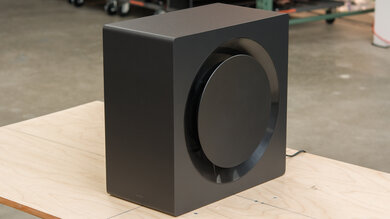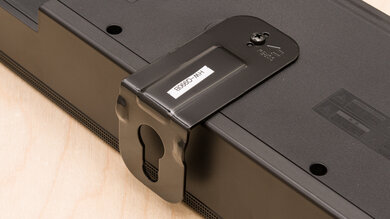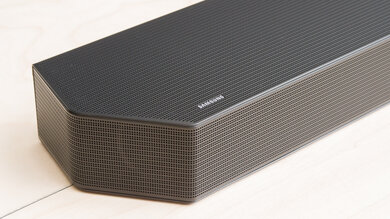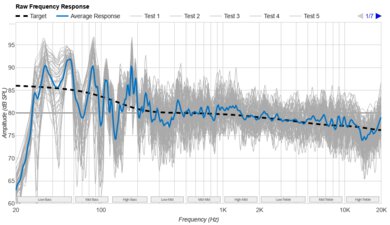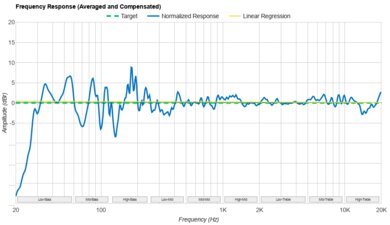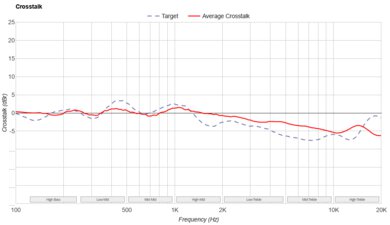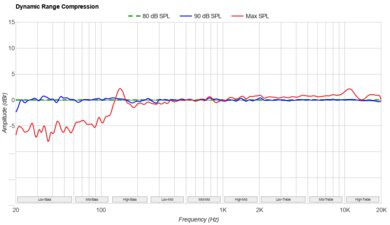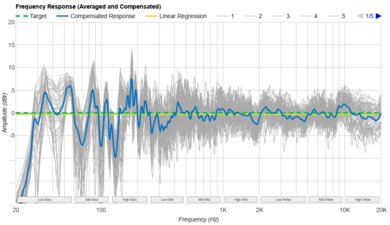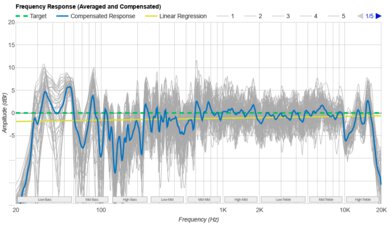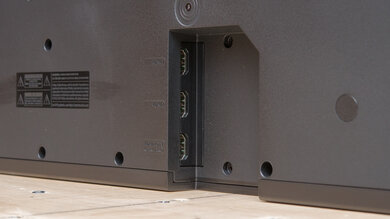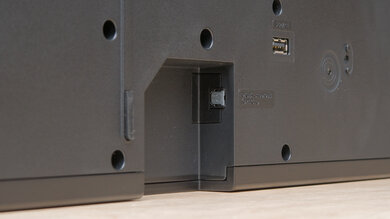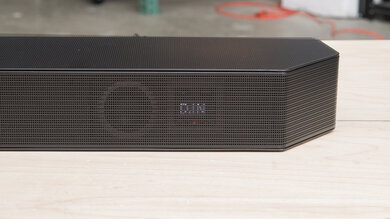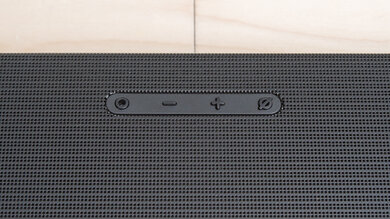The Hisense HS214 is a budget-friendly standalone soundbar with an integrated subwoofer to improve its bass performance. Thanks to its small and compact design, it's easy to fit into your existing setup. Of course, like most models in its price range, it's pretty limited regarding sound enhancement features and support for various audio formats commonly found on streaming services and Blu-rays. Still, it's Bluetooth compatible, and the manufacturer also advertises it as Roku TV Ready, which is handy if you want easy setup with a compatible TV.
Our Verdict
The Hisense HS214 soundbar is sub-par for mixed usage. This small, budget-friendly soundbar makes for an affordable upgrade over your existing TV speakers, but that's about it. Dialogue in movies and TV shows is clearly reproduced, and there are a couple of EQ presets to enhance its sound. However, it lacks a lot of low bass, even with its integrated subwoofer. You won't find many sound customization tools, and there isn't support for a lot of popular audio formats like Dolby Atmos.
- Some EQ presets.
- Gets loud.
- Lacks low bass.
- Minimal sound enhancement features.
- Downmixes surround sound into stereo.
The Hisense HS214 is acceptable for dialogue-centric content like TV shows and podcasts. It's a 2.1 setup, meaning it lacks a dedicated center channel to improve vocal reproduction. Still, it can use its left and right channels to simulate a sound in the center, and voices are clear and easy to follow overall. You can even use its News preset to enhance dialogue in the mix. That said, it doesn't have many customization tools aside from that.
- Some EQ presets.
- Minimal sound enhancement features.
The Hisense HS214 soundbar isn't bad for music. This soundbar lacks a lot of thump and rumble in the low bass, but this is typical for a standalone bar. It still reproduces voices and lead instruments with clarity and accuracy, and its bass adjustment tool helps bring more warmth in the mid-to-high bass range. Plus, it gets loud enough for an average-sized living room. That said, aside from bass adjustment, you won't find many other sound enhancement features to customize its performance.
- Bass adjustment tool.
- Some EQ presets.
- Lacks low bass.
- Minimal sound enhancement features.
The Hisense HS214 soundbar is a poor choice for watching movies. It's a small soundbar, and while it gets loud, it struggles to bring out the deep and rumbling low bass with action-packed scenes. Surround sound formats like Dolby Digital are downmixed into stereo, which brings a less life-like feel to the sound. You won't find support for more advanced formats like Dolby Atmos, either. While the bar comes with a virtual surround mode to enhance its immersive feel, unfortunately, in practice, this tool brings out strange sound artifacts that take away from the overall listening experience.
- Gets loud.
- Lacks low bass.
- Downmixes surround sound into stereo.
Changelog
- Updated Mar 21, 2024: We've added a comparison between this soundbar and the Hisense HS2100 in Stereo Frequency Response.
- Updated Feb 19, 2024: Review published.
- Updated Feb 15, 2024: Early access published.
- Updated Jan 30, 2024: Our testers have started testing this product.
Check Price
Differences Between Sizes And Variants
The Hisense HS214 is available in Black, and you can see the label for the model we tested here.
If you come across another version of this soundbar, please let us know in the forums.
Popular Soundbar Comparisons
The Hisense HS214 is a small standalone soundbar available at an affordable price. It's well-built in comparison with other budget models, though it still lacks higher-end sound enhancement tools and features to make the most of its sound. As with most models with integrated subwoofers, it lacks a lot of low bass. You may find it's worth the value if you want a simple upgrade over your TV speakers, but more avid audiophiles will want to check out more premium options.
See also our recommendations for the best small soundbars, the best soundbars under $100, and the best budget soundbars.
The Hisense HS214 and the Hisense HS2100 are both budget soundbars. While the HS2100 has a 2.1 configuration, the HS214 is a standalone bar with no dedicated subwoofer. As a result, it lacks low bass compared to its 2.1 sibling. It also lacks sound enhancement features, with three default EQ presets and a virtual surround sound feature that subjectively makes vocals and dialogue less clear. It also lacks Dolby Digital and DTS support, which are both present in the HS2100. That said, the HS214 has a better build quality and a more compact design that will fit under smaller TV setups.
The Creative Stage and the Hisense HS214 are both budget-friendly soundbars with different strengths. The Creative Stage is more designed for use with computers, and it comes with a subwoofer, so it can bring more thump and rumble in the bass range. This soundbar can only playback 2.0 PCM content, which is quite limiting, especially since the Hisense supports Dolby Digital.
The Sony HT-S100F and the Hisense HS214 are both budget-friendly standalone soundbars, and the Sony is the best of the two. The Sony is a little wider than the Hisense, but if you have the space, it's worth it since it has more sound enhancement features and a louder sound. That said, it's not quite as well-built as the Hisense.
The Roku Streambar is more expensive than the Hisense HS214, but it's worth it if you want a bar with more sound enhancement features. Unlike the Hisense, it has an auto-volume mode and treble adjustment. Plus, it supports more wireless playback options and has a better stereo soundstage. It's smaller than the Hisense, though it doesn't get quite as loud as its competitor.
Test Results




